The Electric Underfloor Heating Market is estimated to be valued at |USD 2.4 billion in 2025 and is projected to reach USD 4.0 billion by 2035, registering a compound annual growth rate (CAGR) of 5.0% over the forecast period.
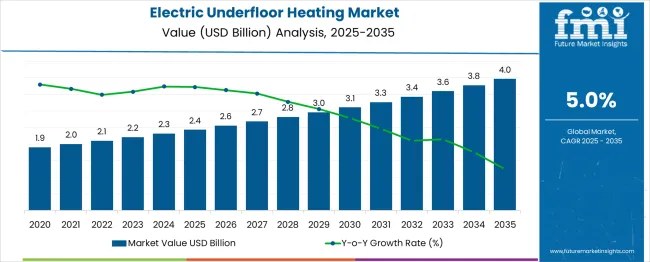
The stainless steel valve tag market is expanding steadily as industrial sectors prioritize asset management, safety compliance, and equipment traceability. Increasing investments in infrastructure and process automation have heightened demand for robust and clear identification solutions capable of withstanding harsh environments.
The shift toward digital transformation in industries such as oil and gas, manufacturing, and utilities is encouraging the adoption of advanced tagging systems that support maintenance and audit operations. Growing awareness around regulatory compliance for equipment labeling and enhanced safety protocols is also influencing market expansion.
The rise of e-commerce platforms has facilitated easier procurement of valve tags, increasing accessibility for small to medium enterprises and broadening geographic reach. Material innovations and customization options continue to enhance product longevity and visibility, creating opportunities for market penetration across diverse industrial applications.
The market is segmented by Facility Type and Application Type and region. By Facility Type, the market is divided into New Buildings and Retrofit. In terms of Application Type, the market is classified into Residential, Commercial, and Industrial. Regionally, the market is classified into North America, Latin America, Western Europe, Eastern Europe, Balkan & Baltic Countries, Russia & Belarus, Central Asia, East Asia, South Asia & Pacific, and the Middle East & Africa.
The market is segmented by Facility Type and Application Type and region. By Facility Type, the market is divided into New Buildings and Retrofit. In terms of Application Type, the market is classified into Residential, Commercial, and Industrial. Regionally, the market is classified into North America, Latin America, Western Europe, Eastern Europe, Balkan & Baltic Countries, Russia & Belarus, Central Asia, East Asia, South Asia & Pacific, and the Middle East & Africa.
The less than 30 mm thickness segment is expected to hold 41.3% of the revenue share in 2025 within the thickness category. This segment’s leadership is supported by its suitability for a wide range of valve sizes and equipment types, providing sufficient durability while minimizing material costs.
The thinner tags offer flexibility in installation, especially in tight spaces and complex piping systems, making them preferable for industries where compactness is critical. Their compatibility with standard mounting hardware and ability to endure corrosion and wear have reinforced demand in sectors emphasizing both performance and cost efficiency.
This balance between robustness and adaptability has contributed to the segment’s dominant position.
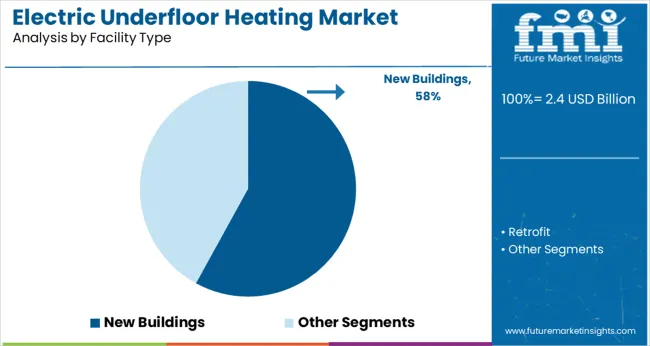
Within the product type category, engraved valve tags are projected to command 57.8% of the market revenue share in 2025, marking them as the leading product form. The prominence of engraved tags is due to their superior legibility, permanence, and resistance to environmental degradation such as fading, scratching, and chemical exposure.
Engraving allows precise and customizable marking, meeting stringent industry standards for traceability and safety. The technique supports complex information including serial numbers, barcodes, and QR codes, enhancing integration with digital asset management systems.
Manufacturers’ emphasis on delivering long-lasting, tamper-proof tags that reduce maintenance costs has reinforced the adoption of engraved tags in heavy industries.
North America is currently the dominating electric underfloor heating market which is attributed to the strong and long-lasting winter in the region. The countries USA and Canada especially contribute to the increasing sales of electric underfloor heating, as the residential and commercial sectors are widely adopting the technology.
Moreover, there is a strong presence of key market players in the region that offer customizable electric underfloor heating, which is further boosting the installation of the same. In addition, people across North America are able to easily install these heating systems owing to the designing of electric underfloor heating systems according to the floor material and structure by most key manufacturers.
Europe is the second largest electric underfloor heating market owing to the demand for energy-efficient heating solutions compared to other forms of central heating systems such as traditional radiators.
These systems are therefore growing in popularity since they provide lower energy bills, lesser maintenance, and reduced overall system costs.
European countries such as Norway, Denmark, Sweden and the Czech Republic experience bitterly cold winters every year, which generate lucrative opportunities for market share.
Construction infrastructure increasing across educational institutes and offices are likely to stimulate product demand. Furthermore, increasing disposable income coupled with the growing demand for high-level comfort, especially in colder countries, may significantly enhance business growth.
Key providers recognize the openness of smart home systems as one of the decisive aspects of high customer satisfaction.
The Cloud API can be integrated into smart devices into the customer’s preferred solutions. Moreover, an individual timer can easily be integrated into the electric underfloor heating systems, for each room offers the user the greatest possible comfort and enables more efficient heating.
Manufacturers ensure that these underfloor heating systems are able to be installed under all kinds of floor coverings such as ceramic tiles, natural stone, tiles, wooden parquet, wooden planks, laminates, any type of wall-to-wall carpets, linoleum and any other floor coverings.
The combination of cold stone floors with electric underfloor heating is growing in popularity. Heating cables or mats can be placed directly under the stone floor to help ensure warm feet and a comfortable temperature in the room.
The adoption of electric underfloor heating is high for stone floors as they lose heat quickly; however, they can also heat up quickly when heating cables or mats are placed directly under the floor. Heating mats can be installed directly on the surface of any old flooring and are applied within the thickness of the tile adhesives, and therefore adds no significant height to the flow level.
These factors are anticipated to significantly contribute to the global electric underfloor heating market growth.
Retrofitting of existing residential establishments is gaining prominence across different geographical regions. In addition, inclination of consumers to invest in comfort & luxury is expected to upsurge the sales of electric underfloor heating.
Moreover, continuous research has led to innovations that help in keeping the floor at a certain temperature throughout the day. This, in turn, is helping the manufacturers to provide better solutions to residential as well as commercial sectors for underfloor heating.
Furthermore, the growing demand for space heating units in several countries with extreme weather conditions is expected to positively influence the market for electric underfloor heating. Rapid urbanization has led to the expansion of multi-story residential and commercial buildings.
These structures require underfloor heating regularly. Thus, manufacturers of underfloor heating are analyzing, understanding and innovating the same as per requirement. In addition, investment by domestic & foreign investors will escalate the electric underfloor heating market demand.
The global demand for electric underfloor heating is projected to increase at a CAGR of 5% during the forecast period between 2025 and 2035, reaching a total of USD 4 Billion in 2035, according to a report from Future Market Insights (FMI). From 2020 to 2024, sales witnessed significant growth, registering a CAGR of 5%.
Although the market is penetrated by various heating equipment, advancement in technology has led to the easy installation of electric underfloor heating.
Various attributes of electric underfloor heating are working in the favor of the same. From weather changes in certain regions to energy-saving capabilities, electric underfloor heating has multi-purpose functions.
In the upcoming years, electric underfloor heating systems are expected to gain prominence as most new construction sites are already installing the same as a necessity. With the construction industry developing rapidly in developing regions, the demand for electric underfloor heating is expected to rise.
Urbanization leading to installation of electric underfloor heating
Migration Data Portal states that 60% of world's population is expected to live in urban areas by 2035. This is owing to better living opportunities along with easier access to good facilities.
Geographically, North America, Europe and Asia Pacific are densely populated. In addition, these regions experience strong winters for a certain period of time every year. Thus, most people living in this area are installing electric underfloor heating to maintain temperatures of the floors, especially for toddlers.
In addition, the ongoing expansion of developing countries has led to the development of real estate divisions that comprise of new building infrastructure along with adoption of various smart city projects.
In addition, many countries are adopting electric underfloor heating technology owing to the rapid climate change across the globe.
Electric underfloor heating systems are effortlessly deployable across new facilities, covering required areas to facilitate cost savings and reduce heat loss.
The space heating industry is regulated by various building regulations and strict carbon emission policies, which in turn, is driving the penetration of energy-efficient and clean heating equipment including electric underfloor heating mat.
Effective heating solution for all spaces increasing adoption of electric underfloor heating
Electric underfloor heating systems are economical compared to hydronic units and can be easily integrated with new & old building infrastructures, thus, complementing the acceptance of the electric underfloor heating technology.
Electric underfloor heating offers effective space heating solutions for small household applications including bathrooms, kitchens, and others.
Significant reduction in the installation time & upfront costs in line with the development of easy-to-use heating mats is working as a key factor for driving the growth of electric underfloor heating especially for the residential sector.
Owing to the ongoing collaboration of government and private players to efficiently deal with extreme winters in various regions, the electric underfloor heating technology is further slated to witness an elevated demand from residential buildings.
In addition, ongoing efforts to promote the rollouts of enhanced & efficient space heating technology across smart cities coupled with the escalating number of green building projects will stimulate the industry growth.
Additionally, substantial development of ready-to-use heating mats and a reduction in installation costs of the units has further instigated a demand growth for the technology in the residential sector.
Longer duration of use leading to higher costs
As the name suggests, electric underfloor heating systems completely function on electric power, making it expensive for regions suffering through extreme cold waves.
Moreover, commercial spaces that require electric underfloor heating system to function for a longer period of time, the running costs have the potential to derail the progress of electric underfloor heating.
Other key factors hampering the growth of electric underfloor heating market are the floor height issue and the installation time taken for the same. Installation of electric underfloor heating takes more time especially in renovation projects.
Furthermore, while retrofitting electric underfloor heating systems, adjusting to the floor height or increasing the same can create issues for the entire infrastructure.
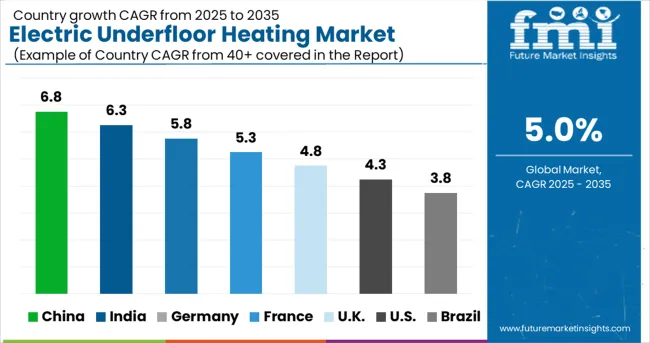
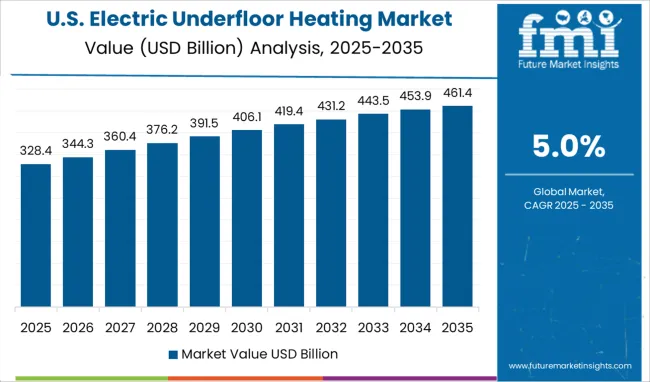
Harsh winter conditions creating opportunities for electric underfloor heating manufacturers
North America is expected to be a major contributor to the electric underfloor heating market owing to the strong and long-lasting winter in the region.
USA especially is driving the sales of electric underfloor heating as the commercial sector and residential sector are widely adapting the technology.
Moreover, rapid development in the construction industry has made electric underfloor heating technology in every household.
In addition, strong presence of ley players in the region that provide customizable electric underfloor heating is further accelerating the installation of the same.
Most manufacturers are designing heat systems according to the floor material and structure, making it easier for people across North America to install the same.
Thus, due to the aforementioned reasons, North America is expected to possess 35% market share by registering a CAGR of 4.5% for electric underfloor heating market in the assessment period 2025 to 2035
Energy-efficient heating systems favouring market growth
Installation of underfloor heating system is not only leading to lower energy bills and reduced overall system costs, but also is demanding lesser maintenance as compared to the traditional radiators.
The growing popularity of the underfloor heating system can be credited to the demand for energy-efficient heating solution compared to the other forms of central heating systems.
European countries such as Norway, Denmark, Sweden and Czech Republic experience coldest winters every year. Thus, the region is creating lucrative opportunities for electric underfloor heating systems.
In addition, electric underfloor heating systems flexibility to install the structure beneath the floor is playing a crucial role in the growth of the same.
Thus, Europe is expected to hold 35% of market share for electric underfloor heating market in the forecast period 2025 to 2035.
Cheaper prices of electric underfloor heating system fueling rapid adoption
Regional players are focusing on reducing the cost of electric heating systems to make it more affordable for the consumers.
This, in turn, is fueling the growth of the market in the region. In addition, increasing investments in the government and private sector in the construction industry is playing a key role in the wide adoption of electric underfloor heating.
China and Japan are driving the market for electric underfloor heating market as the demand for the same is high from the residential sectors. In addition, the reducing prices of the components of the system along with lesser installation charges are making the same affordable for people across the region.
Thus, Asia Pacific is expected to procure 25% market share for electric underfloor heating market in the assessment period 2025 to 2035.
Energy Saving due to electric underfloor heating increasing installation in residential sectors
The growing awareness about the benefits of electric underfloor heating systems is driving the installation of the same in in residential properties.
In addition, the high growth rate of the underfloor heating market for residential applications can be credited to increasing home renovation activities by residents in many developed nations.
Moreover, favorable government regulations and tax credit facilities on installing energy-efficient systems and a high focus on energy savings and minimizing energy bills are playing a key role in the wide adoption of the same.
Electric underfloor heating is gaining popularity for renovations because of the development of innovative technology implemented in the products in this segment.
Thus, by application, residential sectors are expected to hold 50% market share for electric underfloor heating market in the sales indicator period 2025 to 2035.
Modern designs of new buildings easily integrating electric underfloor heating systems
Electric underfloor heating is considered ideal for new buildings and residential structures. In addition, the growing trend of modern design has motivated consumers to create a clean and uncluttered look throughout their homes.
With extreme weather changes in different geographical regions, underfloor heating has become a must. In addition, multiple advantages of installing an electric underfloor heating system in a new house like energy saving, reduced bills and one-time-installation is escalating the adoption of the same in new buildings.
Thus, by facility, new buildings are expected to hold 55% market share for electric underfloor heating market in the forecast period 2025 to 2035.
Key startup players in the electric underfloor heating market are Smart Load Solutions, Carbontec, Themo, Durocan, OTREMA and Tepeo.
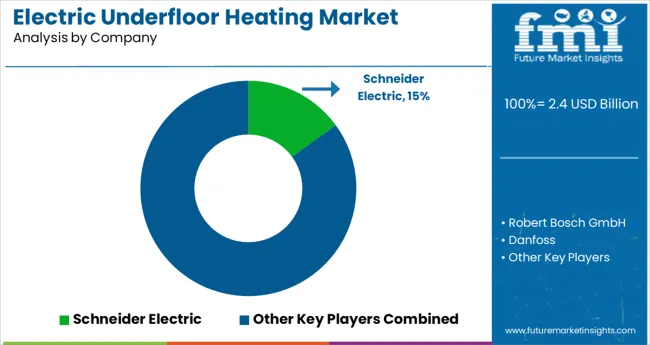
Key players in the electric underfloor heating market include Eberle by Schneider Electric, Robert Bosch, Danfoss, REHAU AG, Uponor Corporation, Amuheat, , Warmup, MAGNUM Heating Group B.V., Heatcom Corporation A / S, Watts, Honeywell International Inc, Hemstedt GmbH, Siemens, Schlüter-Systems, and nVent amongst others.
| Report Attributes | Details |
|---|---|
| Market Value in 2025 | USD 2.4 billion |
| Market Value in 2035 | USD 4.0 billion |
| Growth Rate | CAGR of 5% from 2025 to 2035 |
| Base Year for Estimation | 2024 |
| Historical Data | 2020 to 2024 |
| Forecast Period | 2025 to 2035 |
| Quantitative Units | Revenue in million and CAGR from 2025 to 2035 |
| Report Coverage | Revenue Forecast, Volume Forecast, Company Ranking, Competitive Landscape, Growth Factors, Trends and Pricing Analysis |
| Segments Covered | Facility, Application, Region |
| Regions Covered | North America; Latin America; Europe; Asia Pacific; Middle East and Africa |
| Key Countries Profiled | USA, Canada, Brazil, Argentina, Germany, UK, France, Spain, Italy, Nordics, BENELUX, Australia & New Zealand, China, India, ASEAN, GCC, South Africa |
| Key Companies Profiled | Schneider Electric; Robert Bosch; Danfoss; REHAU AG; Uponor Corporation; Amuheat; Warmup; MAGNUM Heating Group B.V.; Heatcom Corporation A/S; Watts; Honeywell International Inc; Hemstedt GmbH; Siemens; Schlüter-Systems; nVent |
| Customization | Available Upon Request |
The global electric underfloor heating market is estimated to be valued at USD 2.4 billion in 2025.
It is projected to reach USD 4.0 billion by 2035.
The market is expected to grow at a 5.0% CAGR between 2025 and 2035.
The key product types are new buildings and retrofit.
residential segment is expected to dominate with a 49.0% industry share in 2025.






Our Research Products

The "Full Research Suite" delivers actionable market intel, deep dives on markets or technologies, so clients act faster, cut risk, and unlock growth.

The Leaderboard benchmarks and ranks top vendors, classifying them as Established Leaders, Leading Challengers, or Disruptors & Challengers.

Locates where complements amplify value and substitutes erode it, forecasting net impact by horizon

We deliver granular, decision-grade intel: market sizing, 5-year forecasts, pricing, adoption, usage, revenue, and operational KPIs—plus competitor tracking, regulation, and value chains—across 60 countries broadly.

Spot the shifts before they hit your P&L. We track inflection points, adoption curves, pricing moves, and ecosystem plays to show where demand is heading, why it is changing, and what to do next across high-growth markets and disruptive tech

Real-time reads of user behavior. We track shifting priorities, perceptions of today’s and next-gen services, and provider experience, then pace how fast tech moves from trial to adoption, blending buyer, consumer, and channel inputs with social signals (#WhySwitch, #UX).

Partner with our analyst team to build a custom report designed around your business priorities. From analysing market trends to assessing competitors or crafting bespoke datasets, we tailor insights to your needs.
Supplier Intelligence
Discovery & Profiling
Capacity & Footprint
Performance & Risk
Compliance & Governance
Commercial Readiness
Who Supplies Whom
Scorecards & Shortlists
Playbooks & Docs
Category Intelligence
Definition & Scope
Demand & Use Cases
Cost Drivers
Market Structure
Supply Chain Map
Trade & Policy
Operating Norms
Deliverables
Buyer Intelligence
Account Basics
Spend & Scope
Procurement Model
Vendor Requirements
Terms & Policies
Entry Strategy
Pain Points & Triggers
Outputs
Pricing Analysis
Benchmarks
Trends
Should-Cost
Indexation
Landed Cost
Commercial Terms
Deliverables
Brand Analysis
Positioning & Value Prop
Share & Presence
Customer Evidence
Go-to-Market
Digital & Reputation
Compliance & Trust
KPIs & Gaps
Outputs
Full Research Suite comprises of:
Market outlook & trends analysis
Interviews & case studies
Strategic recommendations
Vendor profiles & capabilities analysis
5-year forecasts
8 regions and 60+ country-level data splits
Market segment data splits
12 months of continuous data updates
DELIVERED AS:
PDF EXCEL ONLINE
Residential Electric Underfloor Heating Market Size and Share Forecast Outlook 2025 to 2035
Underfloor Heating Market Size and Share Forecast Outlook 2025 to 2035
Water Underfloor Heating Thermostat Market Size and Share Forecast Outlook 2025 to 2035
Hydronic Underfloor Heating Market Size and Share Forecast Outlook 2025 to 2035
Commercial Underfloor Heating Market Size and Share Forecast Outlook 2025 to 2035
Europe Hydronic Underfloor Heating Market Insights – Trends, Demand & Growth 2025-2035
Examining Europe Hydronic Underfloor Heating Market Share & Trends
Residential Hydronic Underfloor Heating Market Size and Share Forecast Outlook 2025 to 2035
Electric Aircraft Onboard Sensors Market Size and Share Forecast Outlook 2025 to 2035
Electrical Label Market Size and Share Forecast Outlook 2025 to 2035
Electric Round Sprinklers Market Size and Share Forecast Outlook 2025 to 2035
Electric Cloth Cutting Scissors Market Size and Share Forecast Outlook 2025 to 2035
Electrical Insulation Materials Market Size and Share Forecast Outlook 2025 to 2035
Electric Aircraft Sensors Market Size and Share Forecast Outlook 2025 to 2035
Electric Traction Motor Market Forecast Outlook 2025 to 2035
Electric Vehicle Sensor Market Forecast and Outlook 2025 to 2035
Electric Vehicle Motor Market Forecast and Outlook 2025 to 2035
Electric Off-Road ATVs & UTVs Market Size and Share Forecast Outlook 2025 to 2035
Electric Blind Rivet Gun Market Size and Share Forecast Outlook 2025 to 2035
Electric Fireplace Market Size and Share Forecast Outlook 2025 to 2035

Thank you!
You will receive an email from our Business Development Manager. Please be sure to check your SPAM/JUNK folder too.
Chat With
MaRIA